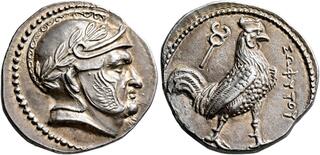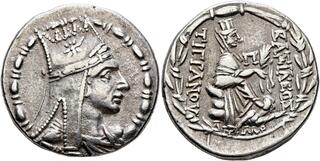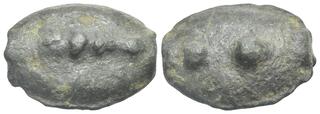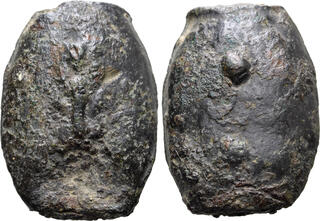Match 1:
| Nomos AG > Auction 32 | Auction date: 8 June 2024 |
| Lot number: 172 Price realized: This lot is for sale in an upcoming auction - Bid on this lot  | |
| Lot description: The Anthony Milavic Collection of Ancient Games Coins Prize Wreaths Simple wreaths MAINLAND GREECE , Macedonia (?). Uncertain City. Uncertain Ruler, Circa 400-350 BC. Chalkous (Bronze, 11 mm, 1.94 g, 7 h). Head of a wolf to right. Rev. A or a monogram of ΑΜ or ΑΜΥ within wreath of somewhat spikey leaves, without any berries. BCD Peloponnesos -. BMC -. HGC 5, -. A. Milavic, A Numismatic Conundrum, The Celator, March 2005, pp. 6-12, and figs. 1-2 (this coin). Extremely rare. Well-struck and with an attractive green patina. Some areas of roughness and struck from a slightly defective reverse die, otherwise, very fine. From the collection of Major Anthony F. Milavic, USMC (Ret.), ex Gorny & Mosch 134, 11 October 2004, 1426. This coin is probably not a games coin at all (!), but it was acquired as one, and, in addition, it is so interesting that it is, none-the-less, included here. When he acquired in 2004, AM was convinced that it was a hitherto unknown coin of Argos because it bore the head of a wolf on its obverse (the usual badge of Argos - but is it a wolf?); because it had an alpha (the usual indication letter for Argos) on the reverse; and because he believed that it was struck c. 200 BC to honor either of two Argive athletes. One who won the stadion at Olympia in 224 and the other who won four consecutive diaulos races at the Olympics in 208, 204, 200 and 196 (since he viewed the wreath as being of olive, the victory had to be at Olympia rather than Nemea). He published this explanation (in The Celator of March 2005) very soon after he acquired the coin. Unfortunately for this very neat and attractive theory, there are a number of decisive objections that make it impossible. 1 The small and thick flan is very much unlike the flans produced in the late 3rd and 2nd century BCE, but it is commonly found in the first half of the 4th century. If it were struck in 4th century BC Argos, which has a fulsome coinage, how would it fit into the series? 2 The fatal objection is the form of the alpha on the reverse: it is what is known as a broken-bar alpha, because the cross bar is not horizontal but v-shaped. This is a typically late feature, which would agree with MA's late date, but which was never used at Argos, neither on Argive Hellenistic coins nor on the city's extensive Roman Provincial issues, which range from Hadrian through Gallienus. So, this coin is not from Argos. On p. 6 of MA's Celator article, we read that this coin was one of 10 pieces of the same type found in modern-day Bulgaria (to our knowledge none of the other 9 has ever appeared elsewhere), which makes an origin in the Peloponnesos highly unlikely. In addition, the letter on the reverse strongly resembles a monogram - most likely ΑΜ or, possibly ΑΜΥ (but what appears to be a Υ may just be a die break) - rather than a simple letter. This suggests that the coin might have been issued by Amyntas II (c. 394/393), who minted silver trihemiobols and bronzes with wolf foreparts on their reverses. But could this enigmatic coin be from somewhere else (where?), and could it be related to games (which?).... Starting price: 650 CHF |  |
Match 2:
| Leu Numismatik AG > Auction 15 | Auction date: 1 June 2024 |
| Lot number: 176 Price realized: This lot is for sale in an upcoming auction - Bid on this lot  | |
| Lot description: BAKTRIA, Local Issues. Sophytos, circa 270s or 240s-230s BC. Didrachm (Silver, 22 mm, 7.87 g, 6 h), Attic standard, uncertain mint in the Oxus region. Male head to right, wearing laureate and crested Attic helmet, cheek guards lowered and decorated with wings; on neck truncation, M. Rev. ΣΩΦYΤΟΥ Rooster standing right; above, kerykeion. Bopearachchi, Sophytes 3A and pl. I, 2. HGC 12, -. Jansari - (O1/-). MGI -. SNG ANS -. Very rare. A spectacular example of this intriguing issue, with a superb portrait of the finest early Hellenistic style and a wonderful reverse. Good extremely fine. Ex Roma XXV, 22 September 2022, 540. There has been extensive discourse regarding the identity and precise dating of Sophytos, an enigmatic Baktrian ruler of uncertain origin who minted a series of magnificent silver coins during the 3rd century BC. First published in 1866 by Sir Alexander Cunningham (1814-1893), Sophytos' coinage exhibits a remarkable fusion of various Greek motifs alongside a distinctly non-Greek name. Cunningham connected the Sophytos from the coins with the Indian ruler Sophytes, who subjected to Alexander in 326 in the Punjab. However, the coins are clearly not from the Punjab, and their iconography also suggests a later period. Indeed, scholars have long noted that the striking helmeted male heads on the obverse are linked to Seleukos' eastern victory series, featuring a helmeted and horned head on the obverse and Nike erecting a trophy on the reverse. Consequently, S. Jansari recently proposed viewing the coins of Seleukos and Sophytos as roughly contemporary, thereby dating the latter's reign to circa 305/4-295 (S. Jansari: Two Sides of the Coin, in: R. Mairs (ed.): The Graeco-Bactrian and Indo-Greek World. London & New York 2021, pp. 487-498). However, Jansari later also suggests dating Sophytos to circa 315-305, implying that his coinage influenced that of Seleukos, rather than the reverse. The latter, especially, is so improbable to the extent that it warrants no consideration here, as it suggests that Sophytos placed his own name on his coins prior to any of the Diadochi. Sophytos' coinage is deeply routed in the iconography of the early Hellenistic era, and it seems much more likely that he followed Greek precursors than the other way around. Indeed, the reverse type on our wonderful didrachm appears to have been directly borrowed from the early Hellenistic coinage of Karystos on Euboia, down to the precise placement of the symbol and legend (see f.e. BCD 572). Jansari rightfully notes that the rooster, the kerykeion, and the wing on the cheek guard all allude to the Greek god Hermes. Additionally, the controls M, MN, and MNA found on Sophytos' coinage are also present on a series of Baktrian imitations of Athenian owls. Notably, Sophytos himself issued an exceedingly rare series featuring owls on the reverse, rendering his coinage less isolated than one might think. The dating of Sophytos' reign remains a subject of debate. There are currently two schools of thought, one aligns Sophytos with the early years of Antiochos I's reign, around the 270s BC, while the other associates him with the usurper Andragoras in Parthia, placing his rule in the 240s and early 230s BC. The former emphasizes Sophytos' connection to the coinage of Seleukos, tracing his issues back to the local Baktrian owl coinage of the 290s and 280s BC. The latter view leans on reported findings that place Sophytos' coins alongside those of Andragoras. Both theories present their strengths and challenges, and it remains premature to determine which will ultimately prevail. Despite being overlooked by Graeco-Roman historiography, we know little about him beyond his evident position of power and his ability to command both resources and skilled artists to produce a most impressive Greek coinage of the finest style. Interestingly, his name, while non-Greek in origin, is not 'Sophytes', as is commonly assumed, as 'Sophytou' is the genitive of 'Sophytos', not 'Sophytes'. This distinction is reinforced by the appearance of the same name, in the nominative case, in the renowned Kandahar inscription. Here, a Sophytos, son of Naratos (or Narates), recounts his life story in erudite Greek in the 2nd century BC. While it has been suggested that this Sophytos might be a descendant of the early Hellenistic ruler, we simply don't know how common the name was amongst the local population, rendering such speculation akin to presuming any English woman named Elizabeth to be a descendant of Queen Elizabeth II. Estimate: 7500 CHF |  |
Match 3:
| Nomos AG > Auction 33 | Auction date: 9 June 2024 |
| Lot number: 1485 Price realized: This lot is for sale in an upcoming auction - Bid on this lot  | |
| Lot description: The Jonathan H. Kagan Collection of Ancient Greek Coins KYRENAIKA. Kyrene. Circa 410 BC. Tetradrachm (Silver, 24 mm, 12.94 g, 6 h). ΑΡΙΣ-ΤΟ-Μ-Η-ΔΕ-ΟΣ Silphium plant with four leaves (two on each side), and four flowers (a large one at the top and three smaller ones above the lower register of leaves); on the right, standing on its hind legs and propping its forelegs on the silphium, is a gazelle, raising its head - with a long ear and a stubby horn - to nibble on a silphium leaf. Rev. Bearded head of Zeus-Ammon to left, with carefully arranged hair, a ram's horn curled around his ear, and with a few tendrils of hair falling down his neck. Cf. BMC pl. XI, 11 (for the obverse) and pl. XII, 1 and 4 (for the reverse). (U. Wartenberg and J.H.Kagan, Silphium, Jerboas, Genets, and the Coinage of Cyrene, in Le Monete di Cirene e della Cirenaica nel Mediterraneo. Problemi e prospettive. Atti del V Congresso Internazionale di Numismatica e di Storia Monetaria, Padova, 17–19 Marzo 2016, ed. M. Asolati, Padova, 2016, pp. 43-56, especially pp. 50-51, 3 and p. 53, fig. 3 (this coin). An extremely rare type, with a particularly naturalistic obverse and a noble head of Zeus-Ammon on the reverse, masterfully engraved. Die flaw on the reverse, otherwise, about extremely fine. From the Collections of Jonathan H. Kagan, and N. B. Hunt, IV, Sotheby's 19-20 June 1991, 521. This coin is quite extraordinary in every way. The head of Zeus-Ammon is of a refined yet powerful Classical style, reminiscent of the Dionysos on the contemporary issues of Thasos and of the more refined heads soon to be produced at Olympia. However, it is the obverse that really catches the eye. What we have is a remarkably lively scene of an animal browsing on a silphium leaf, surely originally drawn from nature. Thus, unlike most ancient coin types, which are probably taken from sculpture - whether in the round or in relief, this type seems to be based on a painting or a drawing. It is quite clear, with the only problem being the identification of the animal on the obverse. Robinson, BMC p, li, description of 92a, called him a gazelle. On the contrary, W & K, in their masterful article cited above, believed that the animal was a genet (in fact, 'The Common Genet' Genetta genetta (Linnaeus), the habitat of which is North Africa - though not in much of Libya, at least in modern times), which is a cat-like creature with a pronounced neck, a long tail and large ears. They also pointed out that gazelles have horns, of which they saw no sign on this coin. However, from what we can see on this coin, and on the piece in Karlsruhe, BMC pl. XI, 10, this creature: has 1) long spindly hind legs, which genets do not have; has 2) a seemingly short and thin tail, unlike the thick bushy ones genets have; has 3) hind legs ending in hooves rather than the paws genets have; and has, clearly visible on this piece, to the left of the ear, 4) a short horn, which is depicted by a short vertical line ending in a knob (there is a clear space between the end of the knob and the edge of the coin; i.e., no part of the design is cut off), and genets do not have horns.Thus, the old identification of the animal on this coin as a gazelle seems certain. In addition, while some have suggested that the silphium was such a small plant that gazelles would not have had to rear up to browse on them - while genets might have had to do so (assuming they, as carnivores, had a taste for silphium leaves), we actually know, from a number of representations on coins (as BMC 11-12 and pl. II, 20-21, BMC 12a-12b and pl. III, 1-2) that silphium plants could be quite tall: the ones illustrated come up to the height of the head of a seated goddess. In another case a standing gazelle is browsing on leaves at the top of a silphium (BMC 15a and pl. III, 6). Starting price: 6500 CHF |  |
Match 4:
| Leu Numismatik AG > Auction 15 | Auction date: 1 June 2024 |
| Lot number: 128 Price realized: This lot is for sale in an upcoming auction - Bid on this lot  | |
| Lot description: KINGS OF ARMENIA. Tigranes the Younger, 77/6-66 BC. Tetradrachm (Silver, 27 mm, 16.18 g, 1 h), Tigranokerta (?), circa 71/0-69/8. Draped bust of Tigranes the Younger to right, wearing five-pointed tiara decorated with a comet star. Rev. BAΣIΛEΩΣ - TIΓPANOY Eutychides' Tyche of Antiochia, turreted and veiled, seated right on rock, holding long palm frond in her right hand; below, river-god Orontes swimming right; in field to right, Π; in exergue, in small letters, ΔHMO; all within wreath. Kovacs pl. 12, 152 (same dies) = SCADA Group 2, A4/P1 (as 'Tigranes II' from the 'Damaskos satellite mint'). Extremely rare, an issue of great historical interest. Well struck, perfectly centered and undoubtedly among the finest known tetradrachms of Tigranes the Younger. Light die roughness on the obverse, otherwise, good very fine. From a European collection, formed before 2005. While earlier authors denied Tigranes the Younger, the son of Tigranes II, any independent coinage, Kovacs has convincingly argued that the extremely rare issues featuring a comet with a tail but no eagles on the tiara should be attributed to the rebellious prince. The young Tigranes, maternally a grandson of the great Pontic king Mithradates VI Eupator, served as a general under his father since the early 70s BC and was acknowledged by him as co-ruler. Dated coins bearing his portrait from the years 71/0-69/8 BC suggest a stay in Damaskos, from where the Tigranids expelled the Ituraean ruler Ptolemy, but the city was lost again due to the onset of conflict with the Romans in 69 BC. In 66 BC, Tigranes the Younger rose against his father with the help of the Parthians but was defeated by him, after which he betrayed the old king to Pompey, who advanced into Armenia the same year. However, the monarch preempted his deposition by a humiliating submission to the Roman general. Pompey, apparently mistrustful of the young Tigranes due to his connections with the Parthians, chose to leave Armenia under the rule of the father and entrusted the son with the insignificant rule over Sophene and Gordiene. Disappointed, Tigranes the Younger allegedly refused an invitation to a banquet by Pompey, prompting the general to depose him shortly thereafter and present him as a captive in his triumph in Rome. The exact circumstances of the episode remain unclear, but an experienced politician like Pompey is unlikely to have acted solely out of wounded pride. Perhaps he saw in the constellation of the old Tigranes II in Armenia and his rebellious son, allied with the Parthians, in neighboring Sophene, too great a risk of further unrest, which threatened to undermine his efforts to stabilize the East. While Kovacs' attribution of the coins to Tigranes the Younger is convincing, his datings raise questions. He attributes the present emission to Tigranokerta or Artagigarta and dates it to the year 66/5 BC, i.e., to the time of the short-lived rule of Tigranes the Younger over Sophene. Such dating would indeed explain the extreme rarity of the tetradrachms and drachms - the former were struck from a single obverse and four reverse dies, the latter from a single pair of dies - but the author overlooks the close connection to a series of tetradrachms of Tigranes II (Kovacs 76.1-3, see also lot 127 above). Not only are they signed with the same name ΔHMO[...], but the portraits are also so similar that they likely belong to the same emission (cf. especially Kovacs pl. 7, 76.2). The bronzes of the younger Tigranes from Damascus from the year 70/69 BC also bear the name of the same official, who thus must have held some sort of powerful position throughout the empire, perhaps as a chancellor or financial minister. Thus, not only is the late dating of the silver coins of Tigranes the Younger obsolete, but it also raises the question of whether the clear stylistic break within the tetradrachms of Tigranes II summarized by Kovacs into one group actually all come from one mint, or whether two different workshops were active here - one might think, for example, of the formerly Seleukid capital Antioch on the Orontes, where Kovacs 71-75 would fit stylistically well (and where they were placed by SCADA), and an eastern mint like Tigranokerta for Kovacs 76 and 152-154. In any case, this cataloguer prefers an early dating of the extremely rare silver coins of Tigranes the Younger, namely to the years 71/0-69/8 BC. The coins thus stem from a time when the father, perhaps in emulation of Seleukid models from the 3rd century BC, appointed the son viceroy of the short-lived Armenian Empire, not expecting that he would be betray him only a few years later. Estimate: 10000 CHF |  |
Match 5:





